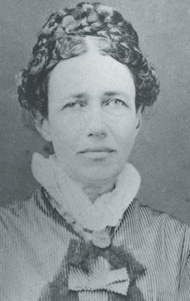Today we pay respect to:
Nurse Kezia Payne DePelchin
Nurse, Social Worker, and Teacher
Yellow Fever epidemics
Mississippi Valley, Houston, Memphis
1872 thru 1893
Nurse Kezia Payne DePelchin’s dedication to her patients and her duty as a Nurse are the  stuff of legends; she represents the thousands of Nurses who have put their lives on the line during epidemics past and present.
stuff of legends; she represents the thousands of Nurses who have put their lives on the line during epidemics past and present.
Kezia Payne DePelchin contracted Yellow Fever as a child in 1839. The virus killed two of her siblings and permanently sickened her father. DePelchin survived and acquired immunity to the virus.
In 1852, when Yellow Fever ravaged southern Texas, DePelchin volunteered to learn Nursing and work as a Nurse in Houston. Despite nursing advances during the mid-19th century and the rise of professional nursing elsewhere, Nursing in the southern states was primitive and not yet professionalized. DePelchin had to provide her own OJT education.
Her immunity made her a precious member of the Nursing team.
She continued to work as a Nurse in Houston during the civil war, and after a failed marriage went to live with a local minister and his wife. She became an integral part of the local charitable activities with women from Houston’s elite families.
In 1878, “Yellow Jack,” the children’s name for the fever, struck Memphis, and DePelchin headed there to lend a hand. Being Immune gave her the ability to work with the most virulent patients without fear of infection.
Despite the heroic efforts of these nurses, 20,000 people died of yellow fever in the Mississippi Valley during the epidemic, including several Nurses.
Although, DePelchin poured her entire being into her work and was a favorite of Houston society. When she began expanding her work in Tennessee, Memphis society viewed DePelchin’s work as a violation of a woman’s proper place.
“It Juss weren’t fittin for a woman to do a man’s work…”
DePelchin took the abuse in stride, knowing her patients needed her. She traveled as a volunteer nurse through Mississippi and Alabama, chasing the epidemic, and providing medical care for its victims.
After the Yellow Jack outbreaks were brought under control, DePelchin focused her efforts on teaching young Nurses Pediatric care. Working as a teacher and matron of an orphanage in Houston, Nurse DePelchin established homes for orphans funding them with her own paycheck and donations from friends.
In 1893 she officially named the children’s house “Faith Home.” It has been modernized but still operates today as the DePelchin Children’s Center.

Today’s Nurse Trivia.
Nurses were considered inferior and unprofessional at the beginning of the Yellow Fever epidemic. They were not treated with any level of respect by Doctors or local political leaders. Despite those prejudices, nearly 3,000 women worked as nurses on yellow fever’s front lines.
Women from out of town were only paid $4 per day; women from within Memphis and black women were paid $3. In contrast, doctors were paid $60 per week. They were treated as social inferiors and refused accommodation at the city’s hotels, which put up doctors.

